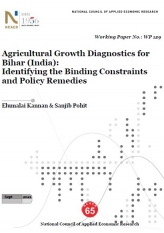Agricultural Growth Diagnostics for Bihar (India): Identifying the Binding Constraints and Policy Remedies
Sanjib Pohit
Elumalai Kannan
September 2021
Agriculture plays a significant role in the economic development of the underdeveloped regions. Bihar in eastern India remains the poorest State despite the introduction of various policy reforms in the agricultural sector since the mid-2000s. We develop a growth diagnostics framework for the agricultural sector in order to identify the most binding constraints on its growth. Our results show that poor functioning of agricultural markets and a low level of crop diversification are the reasons for lower agricultural growth in Bihar. A rise in the level of instability in the prices of agricultural produces indicates that price transmission across the markets is very weak even after repealing of the Market Committee Act. Weak market linkages and non-functional producer collectives are two important constraints responsible for the low level of crop diversification. Our policy suggestions include the state provision of basic market infrastructure to attract private investment in cold storage/warehousing facilities, strengthening of the functioning of ground-level institutions such as farmer producer organisations, and preparation of a comprehensive policy on crop diversification including contract farming.
Agriculture and Rural Development







